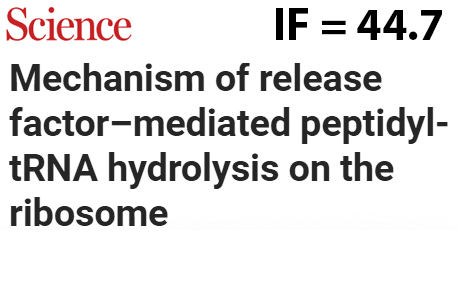
Mechanism of Translation Termination Revealed
Protein biosynthesis by the ribosome is one of the most important reactions in nature. The length of the polypeptide chain is strictly determined by the start and stop codons in mRNA. Translation termination is necessary for the timely completion of protein biosynthesis and the release of the polypeptide product from the ribosome. This process is regulated by specific proteins, the so-called "release factors", which recognize stop codons and mediate the hydrolysis of the ester bond in the peptidyl-tRNA molecule localized in the catalytic center of the ribosome. The new study shows the role of the release factor and the 2'-OH group of tRNA in the catalysis of polypeptide cleavage through the formation of a "bridged" cyclic intermediate. The work was published in the journal Science. Learn more
News 
- Mechanism of Translation Termination Revealed
science news
VI.27 Protein biosynthesis by the ribosome is one of the most important reactions in nature. The length of the polypeptide chain is strictly determined by the start and stop codons in mRNA. Translation termination is necessary for the timely completion of protein biosynthesis and the release of the polypeptide product from the ribosome. This process is regulated by specific proteins, the so-called "release factors", which recognize stop codons and mediate the hydrolysis of the ester bond in the peptidyl-tRNA molecule localized in the catalytic center of the ribosome. The new study shows the role of the release factor and the 2'-OH group of tRNA in the catalysis of polypeptide cleavage through the formation of a "bridged" cyclic intermediate. The work was published in the journal Science.
- The molecular mechanism of redox interaction between neuroglobin and cytochrome c
science news
VI.12 Neuroprotective activity of neuroglobin (Ngb) is presumably based on its redox interaction with cytochrome c (Cyt c), the mechanisms of which have not yet been elucidated. Authors developed a new methodological approach to study the electron transfer between heme proteins based on Raman spectroscopy. We studied the conformational changes in the Cyt c heme and the effect of the protein microenvironment of Cyt c and Ngb hemes on electron transfer between them using developed approach. Obtained data allowed us to propose a step-by-step mechanism of interaction between Ngb and Cyt c. Understanding the mechanisms of interaction between Ngb and Cyt c is necessary for future practical applications related to the therapy of neurodegenerative diseases.
- Why is the bush cricket green?
science news
V.30 A team of scientists with the participation of researchers from the Institute of Bioorganic Chemistry RAS has revealed the nature of the green pigment in the bush cricket Tettigonia cantans. It turned out that the bush cricket owes its protective coloration to a chromoprotein with a unique fold that contains two chromophores simultaneously. One of them is a yellow carotenoid, and the other is a blue bilin. The mixture of the two colors results in a bright green coloration, practically indistinguishable from grass and allowing the animal to cleverly hide. The work has been published in PNAS.
Events 
- Scientific reports by members of the Chinese delegation of Advanced STEM Research Center, Beijing Chaoyang Kaiwen Academy Morning session
science news
VI.18 (This event is over) On Wednesday, June 18, 2025, at 11:00 a.m., Scientific Reports of members of the Chinese delegation of the Advanced STEM Research Center, Beijing Chaoyang Kaiwen Academy will be presented in the Small Hall of the Institute of Bioorganic Chemistry on the 3rd floor of the BON. Everyone is invited.


